
The first thing that comes to mind when talking about a facelift is plastic surgery. However, not everyone wants and can expose themselves to radical influences. A compromise option in this case is many minimally invasive and non-invasive rejuvenation techniques.
Facelift without surgery– this is a whole layer of various procedures that can improve the condition of the skin, get rid of sagging tissue and add clarity to the oval without surgical intervention and associated difficulties.
The main advantages of the technique compared to surgery are relatively low cost, low trauma and fewer contraindications. At the same time, with their help it is not always possible to get such impressive results as after surgery, and they do not last long, usually up to 2-3 years, which partially offsets the cost benefits.
The basic method of lifting without surgery
All non-surgical face lifting procedures can be divided into several large groups:
- Can be injected– subcutaneous administration of drugs that help improve the tone and overall rejuvenation of the skin. This includes, in particular, some types of mesotherapy, contouring and plasma lifting
- Hardware– performed on equipment that uses various types of energy (laser, radio waves, microwaves, etc. ) to affect the skin.
- Lifting with thread– installation of special biocompatible threads under the skin, with the help of which tissue is moved to a new position. Most types of thread lifting are surgical techniques, but they are invasive and the number of contraindications is much lower than in the case of other anti-aging facial surgeries.
- Deep exfoliation, where the upper layer of the dermis is removed. Stimulates skin renewal and thus provides a lifting effect
- Manual practice– various massage techniques aimed at increasing the tone of the facial muscle structure and activating the metabolism.
Injectable lifting and facial rejuvenation
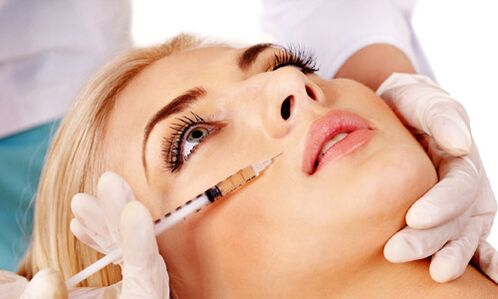
One of the safest and most common methods of this group ismesolifting– a variant of mesotherapy using a complex of active moisturizers and specially selected strengthening ingredients, which activates the cell renewal process, fills it with moisture, and improves local blood circulation. The standard course consists of 3-5 procedures, the duration of the result is from 6 to 18 months. After mesolifting, aging and sagging skin is noticeably smoother, looks fresh and young, deep static wrinkles are reduced and small expression wrinkles disappear, the skin is renewed at the cellular level, the color is even, turgor and elasticity are improved.
PlasmoliftingorPRP therapyis an injection of the patient's own blood (or more precisely, plasma that has undergone special pre-treatment). This course is 4-5 sessions, the results last for about 1 year. Plasmolifting acts locally, at the level of skin cells, triggering the synthesis of collagen fibers, and has a rejuvenating effect on the whole body as a whole - it stimulates the immune system, triggers the process of cell regeneration and renewal. Also, plasma, like biological glue, glues the facial skin to the underlying structure, eliminating age-related tissue ptosis. After finishing the course, the skin is smooth, becomes more elastic, toned, fine wrinkles disappear and deep wrinkles are reduced.
If meso- and plasmolifting have a complex effect on the entire face, tightening and rejuvenating it, thencontour plastic surgery with fillersAndbotulinum therapydesigned to address specific age-related problems.
- Filler injections are intended to fill in deep wrinkles, add volume to lost tissue, and correct the shape of the face. Today, cosmetologists have a wide variety of products at their disposal, mainly based on high-density hyaluronic acid, designed to correct certain age-related facial defects.
- Botulinum therapy uses a drug based on botulinum toxin type A, which blocks nerve endings in the injection area and prevents them from contracting facial muscles. As a result, the skin becomes smooth and deep expression wrinkles are reduced or disappear completely.
The effect of contour and botulinum therapy lasts about 8-12 months, depending on the activity of metabolic processes and other individual characteristics of the body.
Hardware tightening method
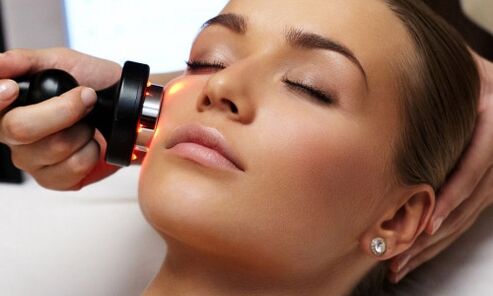
How most methods worklifting hardwarethe same - the subcutaneous tissue is heated by a targeted action, which stimulates the compaction of existing collagen fibers and the production of new collagen and elastin. As a result, wrinkles are smoothed, pores shrink, skin becomes taut and elastic. The main difference between the procedures is the type of energy used (laser, radio waves, etc. ) Otherwise, they are very similar: they are carried out in a course of 3-5 sessions, and the duration of the results is about 2 years. Today the most popular methods are:
- Laser thermolifting– laser energy is used;
- ELOS-lifting– based on the influence of two types of energy at once - laser and light;
- Radio frequency (RF) lifting.– low power and high frequency radio waves are used.
Other choice -microcurrent therapy, – works a little differently. In this case, skin cells are stimulated by microcurrents and a specially developed biological preparation that contains powerful antioxidants that activate the natural mechanisms of skin regeneration.
The standard course of such non-surgical removal consists of 4-5 procedures performed once a week. The main advantages of this method include a minimal number of contraindications and are completely harmless to the body. Microcurrent activates metabolism, normalizes the chemical composition of cells, and increases tissue elasticity - for this reason it is often used as a recovery procedure after surgical intervention.
Lifting with thread
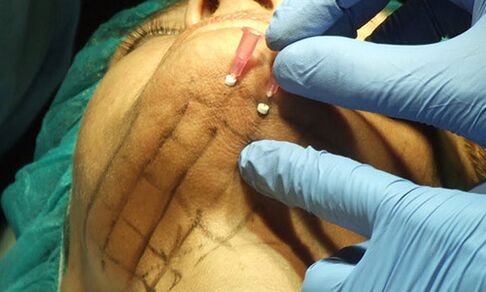
This is a minimally invasive technique where thin threads are inserted under the skin. Then they are pulled up, moving behind them and fixing the soft tissue in the desired position. This procedure is quick and safe, but still quite serious, so it should not be done by a cosmetician who works with the "outside" of the face, but by a plastic surgeon who knows its internal structure. Depending on general indications and the patient's personal preference, the following may be used:
- Non-absorbable thread, made from biocompatible materials such as polypropylene.
- Mesothreads- considered somewhat less effective, but it is made of polylactic acid, which does not remain under the skin, but is completely absorbed after a few months. In addition to the actual tightening, it has a good effect on the general condition and health of the skin (similar to mesotherapy, hence the prefix "meso" in the name)
The results obtained last for an average of 2-3 years, after which you can install additional threads or choose a different technique (threads already installed will not interfere with either cosmetic procedures or surgical removal). Some unabsorbable threads can be "tightened" in the future, but there is no consensus among experts about the appropriateness of such manipulations.
Deep exfoliation
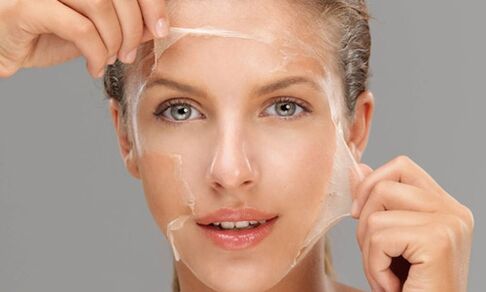
This is quite traumatic and painful, but at the same time a very effective procedure, with the help of which you can improve the regeneration process of the skin, increase its color, smoothness and elasticity, and also eliminate many external defects (hyperkeratosis, hyperpigmentation, etc. other. ).
- currentdeep chemical peelsAn acid composition based on phenol is used on the face, which destroys the upper layer of the skin up to the middle of the reticular layer of the dermis. This procedure is performed only in clinical conditions, under general anesthesia - as a full operation.
- Deep laser resurfacingcombines two processes: using thermal microtrauma on the skin, which triggers internal recovery mechanisms in it and vaporization (evaporation) of old cells. Modern fractional ablative lasers perform these two actions simultaneously, which allows you to achieve a more significant lifting effect in fewer sessions compared to previous generations of lasers.
The recovery period after deep peeling is quite long (recovery takes up to 2 weeks). The effect lasts for about 1 year. If we compare the two procedures, laser resurfacing has one important advantage - the ability to adjust the power and depth of impact "quickly. "This allows you to choose the optimal parameters for each area, even the very sensitive ones (eyelids, lips, neck), which is not possible to achieve with chemical peeling. In addition, the cooling system makes it less painful, allowing the use of local anesthesia.
Massage as a non-surgical facelift method
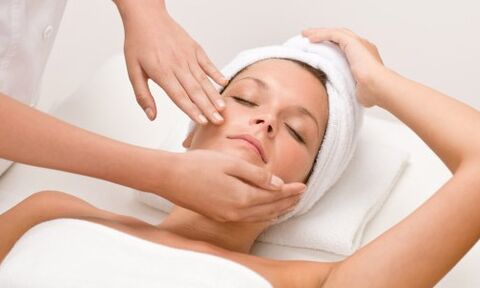
With the help of manual influence it is also possible to achieve a certain lifting effect, although among experts there are very different opinions about its severity and duration. The most popular procedure from this group issequence of sculpture faces(plastic massage, facial massage according to Joelle Siocco and other proprietary techniques).
The principle of action is based on deep strength training of facial and non-facial muscles with simultaneous activation of lymphatic drainage. The massage therapist "sculpts" the contours of the face, correcting problem areas. As a result, ovals become clearer, the manifestations of age-related changes are reduced, muscle tension is relieved, and skin tone improves.
A standard course is 10-12 sessions, which are conducted every 2-3 days. Further maintenance procedures are required 2-3 times a month, which is a relative disadvantage of this non-surgical lifting method. The obvious advantages of sculpture massage are painless, complete safety, no recovery period, no risk of complications, no irritation to the skin. The obvious disadvantage is that the results are less significant compared to the other procedures described above.
How to choose the best non-surgical facelift technique?
In order to smooth and possibly completely eliminate the signs of aging, it is necessary to determine the cause of their appearance. This unique diagnosis is one of the main tasks of a cosmetic specialist or plastic surgeon. It is he who should be entrusted with the choice of specific rejuvenation methods or their combination. In the face case, the question is usually:How localized are age-related changes?
- If it mainly affects the skin – eg. We are talking about small wrinkles, changes in relief, decreased turgor - priority is given to methods that affect the dermis layer (restoration, compaction, strengthening of the elastin-collagen framework, polishing of existing defects). For this purpose, peeling, thermolifting, plasma therapy, and mesolifting are used.
- For problems with the subcutaneous structure of the face (deep wrinkles, clear nasolacrimal furrows, jowls, bags under the eyes, loss of clarity of the face's oval, double chin), choose methods that affect the muscular framework and hypodermis. These include thread lifting, botulinum therapy, contouring, microcurrent and sculpting massage.
- In many cases, the changes affect both the skin and the internal structure, so to get a noticeable effect, a combination of several thoughtful rejuvenation techniques is required.
Expert opinion
Journalists asked leading cosmetic experts to comment on the effectiveness of using certain non-surgical facelift options, and also turned to plastic surgeons for a professional opinion:
"The question is much simpler than it might seem. In order not to make a mistake with the choice of technique, not to undergo surgery earlier than necessary, but also not to spend longer than expected in the cosmetology office, you need to think about only three things:
- Soft tissue condition, degree of ptosis.If the age-related changes do not go too far, we can talk about a non-surgical solution. If we are talking about obvious folds and relatively large excess skin, do not waste time and money on cosmetology, do not engage in self-deception. Excess skin will not go away on its own; it can only be removed with a scalpel, and only a plastic surgeon will help you here.
- Age.Up to age 40 (most often), cosmetic procedures work well. After 40, their effects become less and less noticeable, and after 50, if you need a real effect, and not just care, you should seriously think about surgery.
- Patient wishes.Only you decide who to go to and what you need. Not all women want to look 10-20 years younger; for most people it is important to look presentable and fresh enough for their age. This problem can be solved without surgery. Dull skin tone, sagging, fine wrinkles, age spots, etc. – cosmetologists cope well with all these problems. But if you are not satisfied with sagging facial contours, drooping eyelids, jowls, bags under the eyes, double chin or folds in the neck, just contact the surgeon.
If you need a very small lift, pay attention to vector lifting with multiple threads or contour plastic surgery. By repeating this procedure 1-2 times a year, you can delay the operation for several years. You yourself will be able to understand when the resulting effect no longer suits you and it's time to think about a more radical method. "
"Non-surgical methods, of course, will not replace plastic surgery, but they are a good preventive measure and can delay a visit to the surgeon for a long time. It is advisable for women to use a soft lift (hardware cosmetology) from the age of 25. Almosteach of the methods listed in the article can help with certain subtle age-related changes. Our experts use some of these procedures individually, but most often as part of a comprehensive program.
Therefore, after a surgical facelift, stagnation may occur, which can be easily treated with the help of microcurrent. Contour plastic surgery with fillers allows you to correct minor age-related changes, but in this case plasma fillers (an analogue of hyaluronic acid fillers, produced from the patient's own blood) have proven themselves better.
Botulinum A toxin preparations, of course, give good results and it is impossible to replace them with analogues. RF lifting also provides a good effect for the prevention of aging and during maintenance therapy after plastic surgery. But phenol peeling is not used in our clinic because of its traumatic nature.
A significant advantage of non-surgical lifting procedures is that they can be recommended to patients at a relatively young age, with subtle age-related changes. For example, a gentle alternative to blepharoplasty can be plasma, laser or RF lifting, as well as mesothreads - what exactly to choose will depend on the "severity" of the skin, the depth of wrinkles, the age of the patient and the presence of certain contraindications. "
"I would like to immediately note that, of course, no minimally invasive technique can compete in terms of effectiveness with surgical operations. However, it often happens that the patient's health does not allow him to take such measures, or specific conditions do not yet require surgical intervention. Inin this case, minimally invasive cosmetology helps us.
Thread lifts, laser facelifts and RF facelift techniques may delay the need for surgery and serve as a type of temporary replacement for surgical facelift techniques. Botulinum therapy and fillers can eliminate wrinkles. Plasmolifting improves skin turgor and general condition. Skin is also responsible for skin turgor, color and quality. These procedures are effective in their field of action, but not a direct alternative to plastic surgery.
The clinic performs almost all the procedures described in the article, however, each of them has both indications and contraindications. In particular, for patients who come to us for a total face lift, I recommend plasma lifting before and after surgery, this allows us to shorten the recovery period. But it is not worthwhile to carry out any hardware rejuvenation procedures before surgery. "
"Currently, there are a large number of effective methods of facial rejuvenation without surgery, but it is important to understand the difference in the capabilities of plastic surgeons and cosmetologists. Surgeons create facial contours, cosmetologists improve the quality of the skin. And aging manifests itself in sagging skin and muscles, a decrease in skin color, and a deterioration in its quality. In total, there are about 5 types of aging, depending on their manifestations, and rejuvenation programs are developed, including using non-surgical techniques.
Today, I consider hardware procedures (laser fractional photothermolysis, laser thermolifting), RF lifting, as well as contour plastic surgery and thread lifting to be the most effective. But it should be honestly remembered that with severe ptosis and a large amount of subcutaneous fat, all types of hardware lifting are ineffective, because they affect the inner layer of the skin without affecting its surface. Also, the so-called 3D facial modeling is very popular and effective, which uses a set of steps: contouring, thread lifting, botulinum therapy.
In general, we have a fairly large selection of minimally invasive facelift methods in our arsenal, but for the best results an integrated approach is always required. One method, no matter how good, cannot solve all problems. "
























